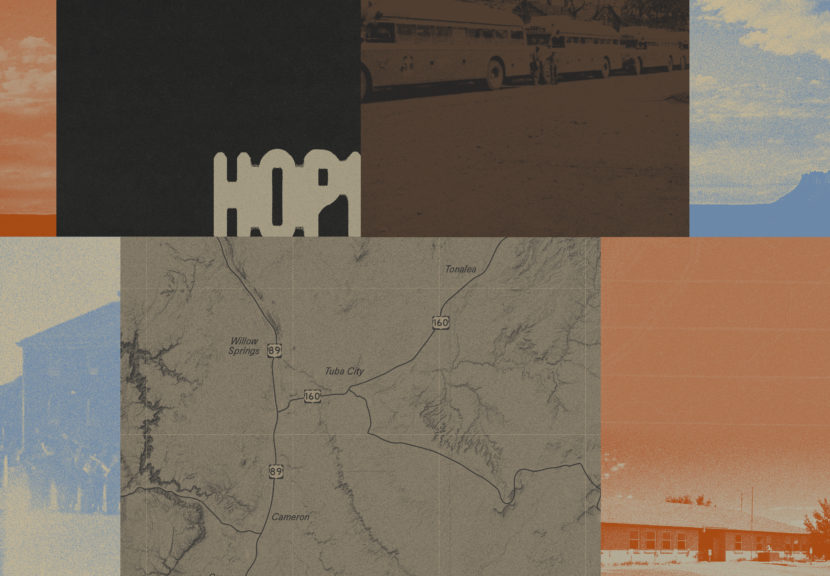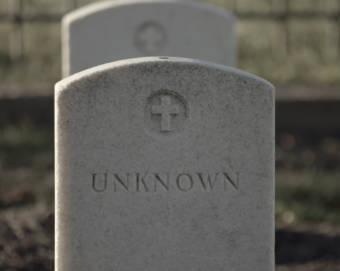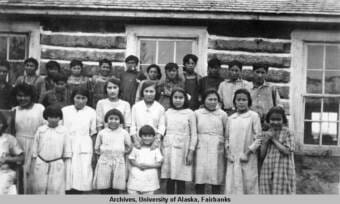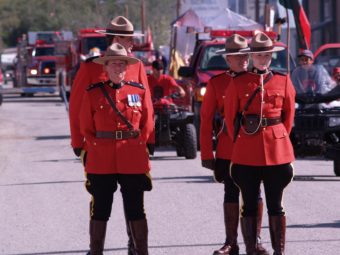
They told Willie Grayeyes (Diné) to sleep in his clothes — to not even take off his black shoes. At any moment, the Tuba City Boarding School staff members said, the 7-year-old would be called upon. Not knowing what that meant, he obeyed, and, in the middle of the night, they woke him. Staffers drove Grayeyes 11 miles to the junction of U.S. Highway 89 and Highway 160 near Tuba City, Arizona, in the Western Agency of the Navajo Nation. There, in the red dinosaur land, he boarded a Greyhound bus. He rode it all night long until early morning, when they arrived in Richfield, Utah for a year in the mid-1950s. He did not go back his second year because the residential hall was full and he was transferred back to Tuba City for another Greyhound bus to the Santa Fe Indian School in New Mexico.
“We were treated in Tuba City like we were in the military,” Grayeyes said, remembering the boarding school system that tried to assimilate him and many thousands of other Indigenous children. “We were marched; we were physically abused by being kicked. I did not know anything at the time of the decree.”
The decree in question was the compulsory attendance mandate employed by the federal boarding school system, which often resulted in the physical, emotional, sexual and spiritual abuse of Indigenous children. The boarding school staff at the Navajo Mountain Boarding and Day School, built between 1934 and 1946 by the Civilian Conservation Corps, had notified the local trading post announcing that Diné children would be rounded up. Any parents, guardians or clan relatives who resisted were punished by law. Grayeyes, now a San Juan County commissioner, was just 6 years old when he first entered the boarding school system in 1953.
“That was my first encounter with an Anglo, a white lady, by the name of Elizabeth Eubank, who was a schoolmaster and teacher,” Grayeyes said. “Ms. Eubank arranged everything, as far as who is going to be transferred and so forth.”
After that first year at the Navajo Mountain Boarding and Day School, he was transferred to the Tuba City Boarding School, established in 1903. He loaded up his suitcases and rode in the flatbed trailer of a government vehicle to get there, 93 miles away from his homelands in Paiute Mesa in the community of Naatsis’áán, San Juan County, Utah. After just a few months at Tuba City, his luggage was returned, and they woke him in the middle of the night so he could take that Greyhound bus to Richfield Residential Hall in Richfield, Utah.
This was life as a boarding school student in northern Arizona and southern Utah — constantly being shuttled around on Greyhound buses or flatbed trailers, never told where you were going or who would be waiting for you when you finally arrived. The only stability to be found was in the black shoes on their feet and the Greyhound buses that trafficked them from school to school.
Grayeyes survived his boarding school experience. Not everyone did. Some students never returned; they went missing or were buried at unmarked graves at various boarding schools across the country. The survivors’ accounts of their experiences — along with the grisly discovery of bodies at residential schools in Canada and the reports of similar discoveries at schools in the U.S. — have finally prompted a federal investigation by the Department of Interior, led by Secretary Deb Haaland (Laguna Pueblo) under the Federal Indian Boarding School Initiative. Earlier this spring, Haaland and Assistant Secretary of Indian Affairs Bryan Newland released the first volume of their investigation. The initial report laid the groundwork, noting that 408 federal schools operated between 1819 and 1969, and that the report’s authors have found unmarked burial sites at 53 different boarding schools, a number that is expected to rise.
Newland and other Interior officials made it clear that this first report was never intended to be conclusive; rather, it should be seen as merely the first step in a long review, with a follow-up report slated for 2023. Meanwhile, there remain countless untold histories — experiences that could be lost if the federal review process doesn’t reach the survivors in time to hear their stories. As investigators listen to survivors and try to map the lingering impact of the boarding schools in the Southwest, one shared experience comes up over and over: the memory of being lined up to board one of those infamous Greyhound buses.
“I remember everybody on a certain day would go up to the local day school, and there would be these Greyhound buses parked up there,” said Leigh J. Kuwanwisiwma, a Hopi historian, former director of the Hopi Tribal Historic Preservation Office and a Christian boarding school survivor. “There used to be just piles of suitcases out on the sidewalk, and they would be loading that (bus) up.”
Hopi students from the villages of Hotevilla and Bacavi boarded buses that took them to the Phoenix Indian Industrial School, more than 200 miles away. Kuwanwisiwma had spoken to other students and felt somewhat prepared for boarding school. His older sister was forced to attend the Ganado Mission School, and her experience there helped him navigate not just school but also the strange customs and fashions, such as the blazer and tie that he wore to Sunday church.
“I remember just kind of going on the road and staring out of the back, just thinking, ‘Man, I’m leaving the rez,”’ Kuwanwisiwma said, recollecting riding in his parents’ 1955 pickup on his way to the Ganado Mission School. “I had this inner feeling of uncertainty inside as we drove through the villages.”
Kuwanwisiwma often felt lonely at the school, but he enjoyed some of the extracurricular activities — becoming a student-athlete at the Hopi Mission School and later at the Ganado Mission School, both Presbyterian-run institutions. He says his experience differed greatly from that of his ancestors, who endured the trauma of compulsory attendance, military discipline and having their hair cut, back in the days when Hopi leaders were jailed for resisting Bureau of Indian Affairs roundups of their children. That was years before the Greyhounds came.
The Greyhound generation remembers more than just the buses and their polished shoes. They also remember the stories of those who went before them.
Kuwanwisiwma’s father and grandfather both went through the BIA boarding school system. His father was forced to attend the Albuquerque Indian School, where he was punished for speaking the Hopi language with other Hopi students. Kuwanwisiwma’s father wanted to protect his own children from the BIA boarding school system, so he encouraged them to go to the mission schools instead, for their primary and secondary education.
As early as 1875, the BIA focused on recruiting Hopi students, often around 4 and 5 years old, from various Hopi villages. In the early 1900s, Kuwanwisiwma’s grandfather was rounded up by U.S. soldiers and forced to attend Keams Canyon Boarding School. His grandfather said that he was out herding sheep when he saw other young Hopi children crying for their parents, and the parents crying for their children. He stood there watching, believing that since he was older, he would not have to go. But the BIA agents told him to come with them anyway. Kuwanwisiwma’s grandfather resisted, running away. He fled from the agents until they fired warning shots into the air. Then he froze, surrendering.
The soldiers took him and the other Hopi children to a small building in Kykotsmovi Village, where the children cried all night while their mothers wept, calling out their Hopi names. The next morning, his grandfather’s long black hair was shaved off. “All their hair was being snipped off, girls and boys. Of, course, long hair was culturally important to both the Hopi boys and men. Long hair meant spiritual strength and courage to face the enemy,” Kuwanwisiwma said. “That’s what long hair means to the Hopi people.”
When his grandfather arrived at Keams Canyon, at the Hopi BIA Agency, the administrator told the soldiers that the boy was too old to attend the school. They let him go, but Kuwanwisiwma said, ashamed of his newly shaven head, hesitated to go home. His parents wondered why he was missing, although he soon came home.
“I tell this story, because around that time, around the turn of the century, there was a big division among the villages of what to expect from the white men,” Kuwanwisiwma said. “The white man was imposing education, and some of the people, the conservatives, the traditionalists did not want that. There was a big conflict developing.”
Ultimately, Kuwanwisiwma’s grandfather sided with the traditionalists and vowed to fight against the white men forever, he said.
“He became a die-hard conservative and traditionalist throughout his life, and those are some of the values I grew up with,” Kuwanwisiwma said.
Kuwanwisiwma holds the same values and is proud that his Hopi people held on to their language, ceremonies and agricultural lifeways. As a historian, he said, he knows that many tribes were less fortunate than his people — the Paiutes, for instance, who were nearly exterminated by the forced boarding school system. For the Paiute Indian Tribe of Utah, as well as Shivwits Band of Paiute Indians and Kaibab Band of Paiutes, the trouble started at the former Panguitch Boarding School, which operated from 1904 to 1909. Superintendent Walter Runke — who started his career as a disciplinarian at Tuba City Boarding School — believed in compulsory attendance, meaning that attendance was enforced at gunpoint, according to a news clipping of the Coconino Sun in the Arizona Memory Project. Historical records from an independent researcher show that at least 12 Paiute children were buried at the Panguitch Boarding School. The site is now part of Haaland’s federal investigation.
Corrina Bow, chairwoman of the Paiute Indian Tribe of Utah, said that a memorandum of understanding between the tribe, the two bands and Utah State University, which leases the former school’s land from the state, has been under negotiation for the last year. The conversations, first reported by the media in August 2021, sparked the investigation of USU’s agricultural lands in the predominantly ranching Mormon community of Panguitch. On behalf of her people, Bow said that she is pleased to have the former boarding school included in the ongoing federal investigation by the Department of Interior. Before the publicity, Panguitch was an unknown residential school.
“As a Tribe, we continue to address the former Panguitch Boarding School and are still saddened by the treatment of our little ones at that school,” Bow said in a statement. “We thank you for respectfully honoring our wishes to address this heartbreaking piece of our history privately following our cultural practices and beliefs.”
Steven Lee, an independent researcher who assisted the tribe, says that the overall narrative around Indigenous boarding schools, including Haaland’s federal report, confirms what he has learned so far: that some Paiute children never returned home, and that the story of the former administrator, Runke, did not end with his tragic stints at Panguitch and the Tuba City boarding schools. Runke went on to oversee a Navajo boarding school, and in 1916, was arrested for killing a Diné man, Taddy Tin, who resisted his recruitment tactics. Runke was acquitted by an all-white jury and later served two terms as an Arizona state senator.
Lee has worked with Bow to find out whether children were buried at the school, studying the school’s old records. He first learned about the traumatic history of Panguitch when he was the town’s events and marketing director. His discovery that a schoolteacher had died from an opium overdose back in 1905 inspired him to do more research, and that led him to the death records of at least 12 Paiute children. But city officials discouraged his research, and he resigned from his job working for the town.
The Interior Department’s first report, Lee said, confirms his own findings: Indigenous children were highly sought after by townspeople, who used them as cheap labor. The report said that USU is waiting for tribal approval to investigate the possible remains of Paiute children, according to Judson Finley, anthropologist and archaeologist at Utah State University.
Meanwhile, Haaland and her team are hosting listening sessions for their second report. Earlier this month, they held a second listening session in the Midwest, giving boarding school survivors the opportunity to tell their stories, some for the first time in their lives. Another listening session for survivors is slated for Arizona later this fall or winter. For the survivors, at least it’s a start.
Despite those memories of the endless Greyhound rides, Grayeyes takes pride in the resilience he and others showed in the face of a system designed to strip him of his cultural identity, starting with cutting off his hair. Today, he proudly wears his tsiiyéél, a Diné hair bun, as he fulfills his various leadership roles — including as the sitting board president of the Navajo Mountain Boarding School.
In his efforts to reclaim the school for the community, Grayeyes has relied on his own experience as a boarding school survivor to inform his decisions about how the school should serve its students. He believes in the importance of parental involvement, something that his generation and the ones before him were denied by the boarding school system. Grayeyes thinks parents need to get involved in their children’s education if they want to help shape the minds of their children in a healthy way.
This same line of thinking informs his beliefs as to what tribal nations and boarding school survivors should get out of the ongoing federal review. The survivors’ needs — their mental health, first and foremost — must be centered. But they deserve more than simply the chance to be heard; they deserve justice and an actual sense of closure. The first report fell short, in Grayeyes’ opinion, who thought it “should have had more depth.” But achieving that depth, as well as any justice or sense of closure, may require more litigious methods than a review process whose continuation depends on a favorable presidential administration.
“If it were up to me,” Grayeyes said, “I would go for a lawsuit (against the federal government). The treatment of Native American students — with the idea to extinguish their lifestyle, their songs, their language — is pretty well planned out.”
Until that happens, however, Grayeyes, like so many others from his generation, will hope for the best from Haaland and her agency, and he’ll continue to work to provide a stable, healthy educational environment — one free of Greyhounds, guns and polished shoes.
Alastair Lee Bitsóí is Diné from Naschitti, Navajo Nation, New Mexico. An award-winning journalist, he formerly reported for The Navajo Times and The Salt Lake Tribune and now works as a correspondent for High Country News and other outlets.
This story was originally published by High Country News and is republished here with permission.



